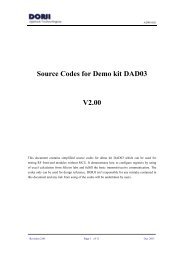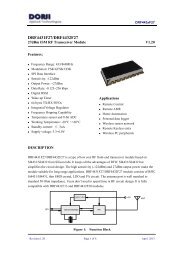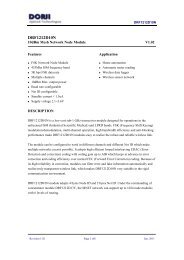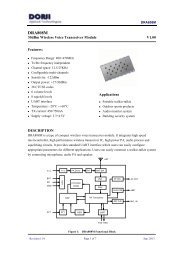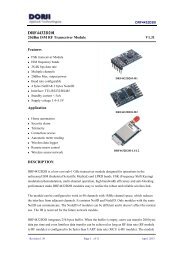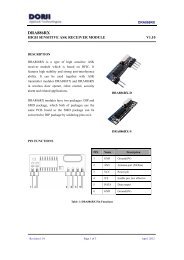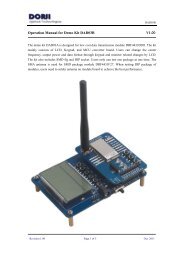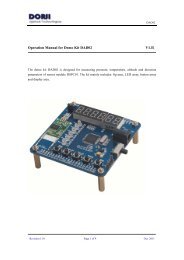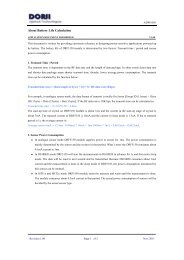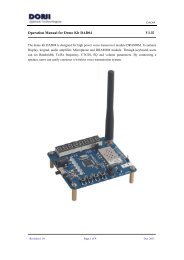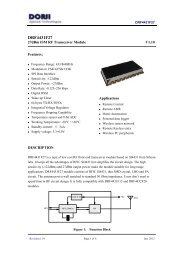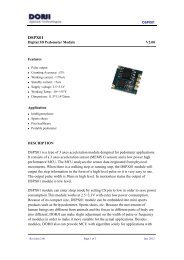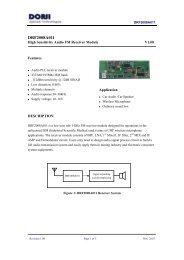MNET Command Explanation - Dorji
MNET Command Explanation - Dorji
MNET Command Explanation - Dorji
You also want an ePaper? Increase the reach of your titles
YUMPU automatically turns print PDFs into web optimized ePapers that Google loves.
ADW1001<br />
<strong>MNET</strong> CONMAND Details<br />
Application notes for metering modules V2.01<br />
The concentrator module (DRF7020M13C) communicates with the host (or server) in ASCII<br />
codes. Lower or upper cases don’t make any influence on commands. The ID of each node<br />
module is the same with the meter in which it is utilized. Usually the ID of node module<br />
(DRF7020M13N) consists 6 bytes in HEX format and its address ranges from 0X00000000000 to<br />
0XFFFFFFFFFFFF, among which 0X000000000000 is the address of concentrator and<br />
0XFFFFFFFFFFFF is reserved by system.<br />
BASIC COMMAND FORMAT<br />
<strong>Command</strong>_Para1_Para2...... ↙<br />
E.g. CMD_Node ID_ Number of response bytes _Data area<br />
• CMD: the command below is for the host communicating with network nodes.<br />
• “_” represents blank character (0X20) and “↙” for return character (0X0D,0X0A)<br />
• Node ID is the ID of network node in HEX format, which is not case sensitive.<br />
• Number of response bytes refers to the Maximum bytes which the node responds. It<br />
can be 1~3 byte long in ASCII format from 0 to 180. E.g. “10” means the length of<br />
responded bytes not exceeding 10 bytes and “180” for not exceeding 180 bytes. 0<br />
means unexpected length of bytes. This parameter is used for calculating network<br />
delay.<br />
• Data area contains the commands sent to node modules by the host (or server)<br />
through the concentrator. Please note the commands must be ASCII format. E.g. if<br />
the command in HEX format is (0X68 0X01 0X23 0X45 0X67 0X89 0XAB 0XCD<br />
0X68 0X02 0X02), it will look like (68_01_23_45_67_89_AB_CD_68_02_02↙)<br />
after being transformed to ASCII format and characters are separated by blank<br />
character.<br />
• The response data from the node modules must also be output in ASCII format. E.g.<br />
the response data in HEX format is (0X68 0X01 0X23 0X45 0X67 0X89 0XAB<br />
0XCD 0X68 0X02 0X02), the corresponding ASCII data will be (ANS-<br />
_68_01_23_45_67_89_AB_CD_68_02_02↙) and characters are separated by blank<br />
character.<br />
Revision 2.01 Page 1 of 9 Jan. 2011
COMMAND<br />
ADW1001<br />
1. DELNET<br />
Format: DELNET↙<br />
Concentrator response: a).OK↙<br />
b).ERR *↙<br />
2. CMD<br />
Notes: 1).The command will delete the ID of all existing nodes and network<br />
data.<br />
2).After deleting the network, the system enters into maintenance<br />
status automatically and will reconstruct the network soon.<br />
3). * means the error type<br />
• 1 unknown command or wrong input<br />
• 2network busy<br />
Format: CMD_Node ID_ Number of responded bytes _Data area↙<br />
Concentrator response: a).OK 2 bytes delay↙<br />
In 1~20 seconds, the concentrator again will respond:<br />
ANS_response data or respond: NO ANS↙ if no data is<br />
received in a certain period<br />
b).ERR *↙<br />
Notes: 1).2 bytes delay (Max. delay for response)<br />
2). * means the error type<br />
• 1 unknown command or wrong input<br />
• 2network busy<br />
• 3 the ID of node module doesn’t exist<br />
3). The length of data area should not exceed 180 bytes. The nodes<br />
communicate with the concentrator in HEX format. The<br />
concentrator must respond and at least send the first byte in the<br />
period (T). The time gap between two bytes mustn’t exceed<br />
20ms and the total response bytes can’t exceed 180 bytes. As to<br />
the setting of T, please check command for more details.<br />
3. TST<br />
Format: TST_Node ID_ Number of responded bytes↙<br />
Concentrator response: a).OK_2 bytes delay↙<br />
In 1~20 seconds, the concentrator again will respond:<br />
ANS_responded data or respond: NO ANS↙ if no data is<br />
received in a certain period<br />
Revision 2.01 Page 2 of 9 Jan. 2011
ADW1001<br />
b).ERR *↙<br />
Notes: 1).2 bytes delay (Max. delay for response)<br />
2). * means the error type<br />
• 1 unknown command or wrong input<br />
• 2network busy<br />
• 3 the ID of node module doesn’t exist<br />
3). The command is used to test the status of network<br />
E.g. TST_1234567890AB_100↙<br />
The node ID is 1234567890AB and the node module will<br />
respond to the concentrator with 100 bytes. After receiving, the<br />
concentrator then outputs:<br />
ANS_00_01_02_03_04_05_06_07_08_09_0A_0B_0C_0D_0E_0F_10_1<br />
1_12_13_14_15_16_17_18_19_1A_1B_1C_1D_1E_1F_20_21_22_23_2<br />
4_25_26_27_28_29_2A_2B_2C_2D_2E_2F_30_31_32_33_34_35_36_3<br />
7_38_39_3A_3B_3C_3D_3E_3F_40_41_42_43_44_45_46_47_48_49_4<br />
A_4B_4C_4D_4E_4F_50_51_52_53_54_55_56_57_58_59_5A_5B_5C_<br />
5D_5E_5F_60_61_62_63↙<br />
4. BCTIME<br />
Format: BCTIME_Year(2 bytes)_ Month(2 bytes)_Day(2 bytes)_Hour(2 bytes)_Minute(2<br />
bytes)_Second(2 bytes)↙<br />
Concentrator response: a).OK 2 bytes delay↙<br />
After 10~15 seconds’ delay, the concentrator again will respond<br />
with BCTIME_END↙<br />
b).ERR *↙<br />
Notes:<br />
1).the execution time of this command is about 10~15 seconds<br />
2). * means the error type<br />
• 1 unknown command or wrong input<br />
• 2network busy<br />
3).After receiving BCTIME command, the node module will<br />
output time with format A<br />
Format A obeys the DLT645-1997 Communication Rules for<br />
multi-functional electric meters. Below are the details of Format<br />
Function: enforce slave stations synchronous with master<br />
Control Code: C=08H<br />
Data length: L=06H<br />
Data area: Yy Mm Dd hh mm ss (compact BCD code)<br />
Revision 2.01 Page 3 of 9 Jan. 2011
ADW1001<br />
Frame format: 68H 99H … 99H 68H 08H 06H ss mm hh DD MM YY CS 16H<br />
Among which ss, mm, hh, DD, MM, YY mean second, minute, day,<br />
month, year correspondingly.<br />
According to Rule 5.3.1 of DLT645-1997, 4 bytes of preamble<br />
(0XFE) should be sent first before sending frame information in<br />
order to wake up the receiving side. The Rule 5.2.5 also stipulates<br />
that each byte of data area should be added with 0X33.<br />
5. RDNODE<br />
Format: RDNODE_Node IDA_ N (number of read modules)↙<br />
Concentrator response: a).OK ↙<br />
Node ID1 routing level (1 Byte)_Node ID1(12 Bytes)<br />
Node ID2 routing level (1 Byte)_Node ID2 (12 Bytes)<br />
… … …<br />
Node IDN routing level (1 Byte)_Node IDN (12 Bytes)<br />
F_ FFFFFFFFFFFF↙<br />
b).ERR *↙<br />
Notes: 1).the concentrator will output data from node IDA (2, 3, 4 … N)<br />
which node IDA is allowed to be a blank node to the host (or<br />
server)<br />
2).If the number of node ID is inefficient or the output is finished,<br />
F _ FFFFFFFFFFFF↙ will be filled or attached at the end<br />
3). * means the error type<br />
• 1 unknown command or wrong input<br />
• 2network busy<br />
• 3 the ID of node module doesn’t exist<br />
4).If the command is input as RDNODE↙ (no parameters), the<br />
concentrator will respond: TOTAL_XXXX↙ which XXXX<br />
represents all of the node IDs.<br />
5).If the command is input as RDNODE _ IDA↙ (no N parameter),<br />
the concentrator will respond: OK_Node ID A routing level (1<br />
Byte) ↙ or else respond: ERR 3↙<br />
6).Because <strong>MNET</strong> is a dynamic network, it can find new node or<br />
remove any node which doesn’t exist in present network timely<br />
so the node number, node ID and node ID routing level will be<br />
affected by the dynamic change of network.<br />
Revision 2.01 Page 4 of 9 Jan. 2011
6. RDFREQ<br />
ADW1001<br />
Format: RDFREQ↙<br />
Concentrator response: a).OK_XXXXXX ↙<br />
b).ERR *↙<br />
Notes: 1). XXXXXX is the frequency used by present network. The unit is<br />
KHz. E.g. for 434.000MHz, the concentrator will respond:<br />
OK_4340000↙<br />
2). * means the error type<br />
• 1 unknown command or wrong input<br />
• 2network busy<br />
7. WRFREQ<br />
Format: WRFREQ_XXXXXX↙<br />
Concentrator response: a).OK ↙<br />
b).ERR *↙<br />
Notes: 1).The writing command is only available for concentrator and will<br />
not affect the parameters of node modules. After the command is<br />
confirmed, users should execute DELNET command and<br />
reconstruct the network.<br />
2). XXXXXX is the frequency set for present network. The unit is<br />
KHz. E.g. for 434.000MHz, the writing command will be:<br />
WRFREQ_4340000↙<br />
3). * means the error type<br />
• 1 unknown command or wrong input<br />
• 2network busy<br />
8. RDNETID<br />
Format: RDNETID↙<br />
Concentrator response: a).OK_XXXXX ↙<br />
b).ERR *↙<br />
Notes: 1). XXXXX is the net ID which ranges from 0 to 65535.<br />
2). * means the error type<br />
• 1 unknown command or wrong input<br />
• 2network busy<br />
Revision 2.01 Page 5 of 9 Jan. 2011
9. WRNETID<br />
ADW1001<br />
Format: WRNETID_XXXXX↙<br />
Concentrator response: a).OK ↙<br />
b).ERR *↙<br />
Notes: 1).The writing ID command is only available for concentrator and<br />
will not affect the parameters of node modules. After the<br />
command is confirmed, users should execute DELNET command<br />
and reconstruct the network.<br />
2). XXXXX is the net ID which ranges from 0 to 65535.<br />
3). * means the error type<br />
• 1 unknown command or wrong input<br />
• 2network busy<br />
10. MTNET<br />
Format: MTNET↙<br />
Concentrator response: a).OK ↙<br />
b).ERR *↙<br />
Notes: 1).After executing the command, the network will be in active<br />
status. The concentrator and node modules might transmit or<br />
receive data voluntarily.<br />
2). When DELNET command is executed, the network will enter<br />
into maintenance status automatically.<br />
3). * means the error type<br />
• 1 unknown command or wrong input<br />
• 2network busy<br />
11. STOPMT<br />
Format: STOPMT↙<br />
Concentrator response: a).OK ↙<br />
b).ERR *↙<br />
Notes: 1).The network will be in SILENT status after executing the<br />
command for 30 seconds or less. The concentrator and node<br />
modules will not transmit data voluntarily.<br />
2). * means the error type<br />
• 1 unknown command or wrong input<br />
• 2network busy<br />
Revision 2.01 Page 6 of 9 Jan. 2011
12. STATUS<br />
ADW1001<br />
Format: STATUS↙<br />
Concentrator response: a).NOMIC ↙<br />
b).STOP↙<br />
c).ERR *↙<br />
Notes: 1).If the network is in maintenance status. The concentrator will<br />
respond NOMIC ↙ or else respond STOP↙<br />
2). * means the error type<br />
• 1 unknown command or wrong input<br />
• 2network busy<br />
13. RATE<br />
Format: RATE_XXXX↙<br />
Concentrator response: a).OK ↙<br />
b).ERR *↙<br />
Notes: 1).XXXX is the serial data rate which can be one of them below:<br />
9600bps, 19200bps, 38400bps, 57600bps, 115200bps.<br />
E.g. to change the data rate to 115200bps, the command can be:<br />
RATE_115200↙. It comes into effect after the concentrator<br />
respond: OK↙<br />
2). * means the error type<br />
• 1 unknown command or wrong input<br />
• 2network busy<br />
14. IODELAY<br />
Format: IODELAY_XX↙<br />
Concentrator response: a).OK ↙<br />
b).ERR *↙<br />
Notes:<br />
1).XX can be one of the values showed as below:<br />
05,10,15,20,25,30,35,40 which are corresponding to 0.5s, 1s, 1.5s,<br />
2s, 2.5s, 3s, 3.5s, 4 seconds.<br />
It comes into effect after the concentrator respond: OK↙. If no<br />
parameter is attached to the command: IODELAY↙, The<br />
concentrator will use default setting (05).<br />
2). * means the error type<br />
• 1 unknown command or wrong input<br />
• 2network busy<br />
Revision 2.01 Page 7 of 9 Jan. 2011
ADW1001<br />
15. MRATE<br />
Format: MRATE_XXXX↙<br />
Concentrator response: a).OK ↙<br />
b).ERR *↙<br />
Notes: 1).The purpose of this command is for calculating network delay<br />
and can’t change the actual FSK data rate of node modules with<br />
which the concentrator’s FSK data rate must be kept the same.<br />
The FSK data rate of node module can be revised through RF<br />
TOOL.<br />
2). XXXX can be one of the data rates below:<br />
1200bps, 2400bps, 4800bps, 9600bps, 19200bps, 38400bps,<br />
57600bps<br />
If no parameter is attached to the command: MRATE↙, The<br />
concentrator will use default setting (19200).<br />
3). * means the error type<br />
• 1 unknown command or wrong input<br />
• 2network busy<br />
Revision 2.01 Page 8 of 9 Jan. 2011
ADW1001<br />
<strong>Dorji</strong> Applied Technologies<br />
A division of <strong>Dorji</strong> Industrial Group Co., Ltd<br />
Add.: Xinchenhuayuan 2, Dalangnanlu, Longhua,<br />
Baoan district, Shenzhen, China 518109<br />
Tel: 0086-755-28156122<br />
Fax.: 0086-755-28156133<br />
Email: sales@dorji.com<br />
Web: http://www.dorji.com<br />
<strong>Dorji</strong> Industrial Group Co., Ltd reserves the right to<br />
make corrections, modifications, improvements and<br />
other changes to its products and services at any time<br />
and to discontinue any product or service without<br />
notice. Customers are expected to visit websites for<br />
getting newest product information before placing<br />
orders.<br />
These products are not designed for use in life support<br />
appliances, devices or other products where<br />
malfunction of these products might result in personal<br />
injury. Customers using these products in such<br />
applications do so at their own risk and agree to fully<br />
indemnify <strong>Dorji</strong> Industrial Group for any damages<br />
resulting from improper use.<br />
Revision 2.01 Page 9 of 9 Jan. 2011



